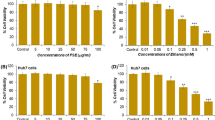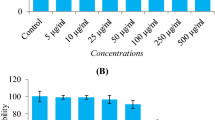Abstract
Although animal fat has been reported to be an effective preventative agent for cardiovascular disease, pancreatitis and diabetes, its protective effects against hepatotoxicity have not been thoroughly investigated. Therefore, in this study, the anti-hepatotoxic activity of oil extracted from the forehead of Neophocaena asiaeorientalis (OFNA) was investigated. Changes in cell viability, cell morphology, cell cycle, and apoptotic protein expression were measured in HepG2 cells co-treated with hydrogen peroxide (H2O2) and OFNA. OFNA contained 19.3 g/100 g docosahexaenoic acid, 8.2 g/100 g eicosapentaenoic acid, and 19.6 g/100 g palmitoleic acid. Cell viability did not differ significantly between vehicle-treated and 0.1–1% OFNA-treated cells. The minimum concentration of H2O2 required to cause the death of HepG2 cells was 1 mM. Cell viability was higher in the group treated with H2O2 plus OFNA (0.1, 0.5, 0.7 and 1%) than in the group treated with H2O2 alone, and OFNA protected against H2O2-induced apoptosis in a dose-dependent manner. The ratio of Bax/Bcl-2 was reduced in response to treatment with the OFNA combination compared to H2O2 alone. Interestingly, 2′,7′-dichlorodihydrofluorescein diacetate staining showed a reduction of oxidative stress induced by H2O2 after pre-treatment with OFNA. Taken together, these results suggest that OFNA protects cells against H2O2-induced death, and suggest that it has potential for use as a preventive agent for various types of hepatic injury caused by chemical substances.







Similar content being viewed by others
References
Castillo M, Amalik F, Linares A, Garcia-Peregrin E (2000) Fish oil reduces cholesterol and arachidonic acid levels in plasma and lipoproteins from hypercholesterolemic chicks. Mol Cell Biochem 210:121–130
Chun B-S (2010) Phospholipids isolation from squid viscera residues after supercritical carbon dioxide extraction. Korean Chem Eng Res 48:741–746
Cobbina E, Akhlaghi F (2017) Non-alcoholic fatty liver disease (NAFLD)—pathogenesis, classification, and effect on drug metabolizing enzymes and transporters. Drug Metab Rev 49:197–211
Conning DM, Phillips JC (1986) Comparative metabolism of BHA, BHT and other phenolic antioxidants and its toxicological relevance. Food Chem Toxicol 24:1145–1148
Dasilva G, Pazos M, Garcia-Egido E, Gallardo JM, Rodriguez I, Cela R, Medina I (2015) Healthy effect of different proportions of marine omega-3 PUFAs EPA and DHA supplementation in Wistar rats: lipidomic biomarkers of oxidative stress and inflammation. J Nutr Biochem 26:1385–1392
Debib A, Dueñas M, Boumediene M, Mothana RA, Latifa A, Tir-Touil MA (2016) Synergetic hepatoprotective effect of phenolic fractions obtained from Ficus carica dried fruit and extra virgin olive oil on CCL4-induced oxidative stress and hepatotoxicity in rats. J Food Biochem 40:507–516
Erol-Dayi O, Arda N, Erdem G (2012) Protective effects of olive oil phenolics and gallic acid on hydrogen peroxide-induced apoptosis. Eur J Nutr 51:955–960
Ezraty B, Vergnes A, Banzhaf M, Duverger Y, Huguenot A, Brochado AR, Su SY, Espinosa L, Loiseau L, Py B, Typas A, Barras F (2013) Fe–S cluster biosynthesis controls uptake of aminoglycosides in a ROS-less death pathway. Science 340:1583–1587
Ferramosca A, Di Giacomo M, Zara V (2017) Antioxidant dietary approach in treatment of fatty liver: new insights and updates. World J Gastroenterol 23:4146–4157
Giordano E, Visioli F (2014) Long-chain omega-3 fatty acids: molecular bases of potential antioxidant actions. Prostaglandins Leukot Essent Fatty Acids 90:1–4
Hussain T, Tan B, Yin Y, Blachier F, Tossou MC, Rahu N (2016) Oxidative stress and inflammation: what polyphenols can do for us? Oxid Med Cell Longev 2016:7432797
Joo T-W, Hong S-H, Park S-Y, Kim G-Y, Jhoo J-W (2016) Antioxidant effects of eriodictyol on hydrogen peroxide-induced oxidative stress in HepG2 Cells. J Korean Soc Food Sci Nutr 45:510–517
Kanaan GN, Harper ME (2017) Cellular redox dysfunction in the development of cardiovascular diseases. Biochim Biophys Acta 11:2822–2829
Keren I, Wu Y, Inocencio J, Mulcahy LR, Lewis K (2013) Killing by bactericidal antibiotics does not depend on reactive oxygen species. Science 339:1213–1216
Kim DO, Lee CY (2004) Comprehensive study on vitamin C equivalent antioxidant capacity (VCEAC) of various polyphenolics in scavenging a free radical and its structural relationship. Crit Rev Food Sci Nutr 44:253–273
Kim D-W, Kim K-H, Hong J-K, Cho K-H, Sa S-J, Kim Y-M, Park J-C, Seol K-H (2014) Comparision of carcass characteristics, meat quality, and fatty acid profiles between Duroc and corssbred pigs (Duroc × Korean native pig). Korean J Agric Sci 41:425–431
Kozlov S, Afonin A, Evsyukov I, Bondarenko A (2017) Alzheimer’s disease: as it was in the beginning. Rev Neurosci 28(8):825–843
Lee KJ, Jeong HG (2007) Protective effects of kahweol and cafestol against hydrogen peroxide-induced oxidative stress and DNA damage. Toxicol Lett 173:80–87
Lee MY, Jung HR, Lim CH (2009) Analysis on developmental factors of the liver diseases in ultrasound diagnosis of healthcare. J Korean Soc Radiol Tech 32:79–86
Lee YR, An YR, Park KJ, Sohn H, An DH, Kim SA (2013) Age and reproduction of the finless porpoises, Neophocaena asiaeorientalis, in the Yellow Sea, Korea. Anim Cells Syst 17:366–373
Liu Y, Imlay JA (2013) Cell death from antibiotics without the involvement of reactive oxygen species. Science 339:1210–1213
Liu H, Liu X, Zhang C, Zhu H, Xu Q, Bu Y, Lei Y (2017) Redox imbalance in the development of colorectal cancer. J Cancer 8:1586–1597
Monroig O, Tocher DR, Navarro JC (2013) Biosynthesis of polyunsaturated fatty acids in marine invertebrates: recent advances in molecular mechanisms. Mar Drugs 11:3998–4018
Moon S-K, Lee D-S, Yoon H-D, Kim Y-K, Yoon NY, Kim I-S, Jeong B-Y (2012) Proximate and fatty acid compositions of three species of imported and domestic freshwater fishes. Korean J Fish Aquat Sci 45:612–618
Parida AK, Das AB (2005) Salt tolerance and salinity effects on plants: a review. Ecotoxicol Environ Saf 60:324–349
Park K-J, An Y-R, Lee Y-R, Park J-E, Moon D-Y, Choi S-G (2011) Feeding habits and consumption by finless porpoises (Neophocaena asiaeorientalis) in the Yellow Sea. Korean J Fish Aqua Sci 44:78–84
Poole LG, Dolin CE, Arteel GE (2017) Organ-organ crosstalk and alcoholic liver disease. Biomolecules 7:62
Rani V, Deep G, Singh RK, Palle K, Yadav UC (2016) Oxidative stress and metabolic disorders: pathogenesis and therapeutic strategies. Life Sci 148:183–193
Redza-Dutordoir M, Averill-Bates DA (2016) Activation of apoptosis signalling pathways by reactive oxygen species. Biochim Biophys Acta 1863:2977–2992
Sen CK, Packer L (1996) Antioxidant and redox regulation of gene transcription. FASEB J 10:709–720
Siegel G, Ermilov E (2012) Omega-3 fatty acids: benefits for cardio-cerebro-vascular diseases. Atherosclerosis 225:291–295
Simopoulos AP (1991) Omega-3 fatty acids in health and disease and in growth and development. Am J Clin Nutr 54:438–463
Sohn H, Park KJ, An YR, Choi SG, Kim ZG, Kim HW, An DH, Lee YR, Park T-G (2012) Distribution of whales and dolphins in Korean waters based on a sighting survey from 2000 to 2010. Korean J Fish Aquat Sci 45:486–492
Suarez-Jimenez GM, Lopez-Saiz CM, Ramirez-Guerra HE, Ezquerra-Brauer JM, Ruiz-Cruz S, Torres-Arreola W (2016) Role of endogenous and exogenous tocopherols in the lipid stability of marine oil systems: a review. Int J Mol Sci 17:1968
Suzek H, Celik I, Dogan A, Yildirim S (2016) Protective effect and antioxidant role of sweetgum (Liquidambar orientalis) oil against carbon tetrachloride-induced hepatotoxicity and oxidative stress in rats. Pharm Biol 54:451–457
Swanson D, Block R, Mousa SA (2012) Omega-3 fatty acids EPA and DHA: health benefits throughout life. Adv Nutr 3:1–7
Wang Y, Feinstein SI, Fisher AB (2008) Peroxiredoxin 6 as an antioxidant enzyme: protection of lung alveolar epithelial type II cells from H2O2-induced oxidative stress. J Cell Biochem 104:1274–1285
Xiao X, Liu J, Hu J, Zhu X, Yang H, Wang C, Zhang Y (2008) Protective effects of protopine on hydrogen peroxide-induced oxidative injury of PC12 cells via Ca2+ antagonism and antioxidant mechanisms. Eur J Pharmacol 591:21–27
Acknowledgements
This research was supported by grants to Dr. Dae Youn Hwang from the Korea Institute of Planning Evaluation for Technology of Food, Agriculture, Forestry and Fisheries (116027-032-HD030).
Author information
Authors and Affiliations
Corresponding author
Ethics declarations
Conflict of interest
The authors report that they have no conflicts of interest. The authors alone are responsible for the content and writing of this paper.
Additional information
Publisher's Note
Springer Nature remains neutral with regard to jurisdictional claims in published maps and institutional affiliations.
Rights and permissions
About this article
Cite this article
Kim, H.R., Kim, J.E., Yun, W.B. et al. Protective effect of oil extracted from Neophocaena asiaeorientalis against hydgrogen peroxide-induced oxidative stress in HepG2 cells. Fish Sci 85, 867–876 (2019). https://doi.org/10.1007/s12562-019-01329-9
Received:
Accepted:
Published:
Issue Date:
DOI: https://doi.org/10.1007/s12562-019-01329-9




